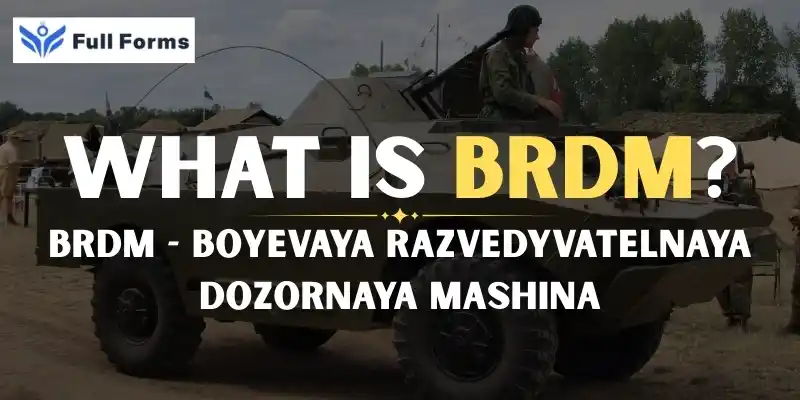Boyevaya Razvedyvatelnaya Dozornaya Mashina
(BRDM)

Description
Boyevaya Razvedyvatelnaya Dozornaya Mashina (BRDM): Eyes and Ears of the
In modern combat, knowledge is just as critical as firepower. Having a view of the enemy’s location, actions and intentions often spells out the difference between victory and defeat. Reconnaissance vehicles typically fill in this gap; among the most well-known and widely used reconnaissance vehicles is BRDM. An acronym for Boyevaya Razvedyvatelnaya Dozornaya Mashina, BRDM falls back to Russian where it means essentially “Combat Reconnaissance Patrol Vehicle.”
For decades now, the BRDM has seen use by military forces all over the world. Let's get a closer look at what it is, how it works, and why anybody would think that it's still important!
Boyevaya Razvedyvatelnaya Dozornaya Mashina
Boyevaya Razvedyvatelnaya Dozornaya Mashina is a four-wheeled lightly armored military scout car produced by the Soviet Union. It performs reconnaissance and patrol duties, which cover spotting enemy locations, obtaining data, and safeguarding advancing personnel.
The major variants of BRDM are:
- BRDM-1 - introduced in the 1950s
- BRDM-2 - An improved variant was introduced in the 1960s.
Both models were made to survive in harsh conditions, including snow tracks, shallow waters, and cross-country routes.
Design and Features
1. Armour & Protection
The BRDM carries light armour with a good capacity to provide it with protections against small arms fire and shell fragments. It was never designed as a direct fighting vehicle; it was meant to keep you alive while scouting.
The best feature about BRDM is its high maneuverability. It can traverse on rugged terrains and at the same time since it is amphibious, it can float and propel in water with the help of a small water jet located at the rear side. With this feature, troops can cross rivers and marshes without requiring any bridge.
The BRDM-2 has four main wheels and four belly wheels, all of which can be retracted. The stability of the vehicle increases with the lowering of these belly wheels, and therefore better traction is achieved on soft ground. This means that it is better than most for off-road driving.
Speed: Up to about 100 km/h on land
In water: something near 10 km/h - good for river crossing.
A normal BRDM-2 is armed with a heavy machine gun and in some variants, an additional co-axial machine gun. These weapons are primarily used for self-defense while conducting missions.
What it does and why it matters in combat
The BRDM does not fall under the category of frontline combat vehicles; rather, its primary functions include:
- Enemy reconnaissance
- Border and frontline inspection
- Convoy leading
- Battlefield information relay
- Assisting command elements in reconnaissance
Low silhouette, adequate armor, and high mobility over cross-country terrain are characteristics that make it suitable for such roles.
Variants and Modernizations
There are numerous variants and modernizations of the BRDM vehicles. A few of them are:
- Anti-tank versions with guided missile launchers
- Versions equipped with radar for detecting aircraft or automobiles
- Command variants equipped with additional radios and communication facilities
- NBC recon variants hunt threats to the battlefield.
There are also numerous improvised BRDMs by different states with upgraded engines, armor, and sensors among others.
Global Operation
Over fifty countries have operated it just like the BRDM.
- The Russian Federation
- India
- Iraq
- Poland
- Vietnam
- Angola
- Syria
Because they are easy to use, durable, and multipurpose, many countries still operate or keep BRDMs in their army stockpiles decades after their production.
Advantages of the BRDM :
- Reliable on harsh grounds
- It can survive both water and land conditions
- Simple to maintain
- Useful for a number of tasks
- Not large and simple to move
Disadvantages:
- Light armor - not very good protection against heavy weapons.
- Not potent in direct confrontation with enemy tanks or armored vehicles due to low firepower.
- Obsolete design: Drones and high-technology sensors are part of modern reconnaissance, to be accurate read.
Despite all these shortcomings, the BRDM does carry on in use for basic patrolling and support roles, particularly in lower-end countries that do not have a large amount of money available for more advanced vehicles.
What Will Happen to BRDM-Type Vehicles
The first BRDMs may get old, but their concept never dies. In the new improvized reconnaissance vehicles that modern armies are conceptualizing, the same idea lives on with added features:
- Heat sighting cameras
- Remote controlled weapons systems
- GPS and SatComms
- Faster engines, better armor
The BRDM is still relevant for many developing countries, particularly when it is upgraded with new technology.
The Boyevaya Razvedyvatelnaya Dozornaya Mashina (BRDM) meant much more than just some old military vehicle, it is lifeblood to speak of toughness by design. Useful engineering, it was meant to go where danger was, collect intell and return safely. Meaning commanders could then make decisions based on good information.
The BRDM is in service today, despite the gradual induction of newer systems. To the soldiers, it remains a trusted companion because it can protect them, facilitate their movement, and provide information; so long as it can do all this, then BRDM has to be around. It would still find great utility for nations who prioritize finding usable and flexible defense solutions—decades since its original introduction.
